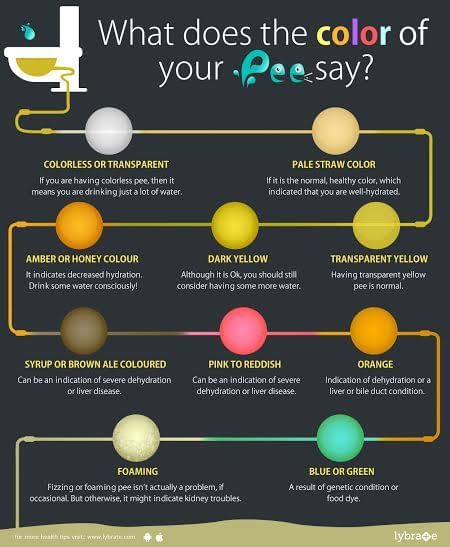Have you ever wondered what it’s like to live and work in space? Imagine floating weightlessly, gazing at the Earth from a distance, and conducting groundbreaking research that pushes the boundaries of human knowledge. But amidst the grandeur of space exploration, there’s a surprisingly mundane and universal truth: we all pee the same color, astronauts and earthlings alike.

Image: dooleaw.com
While the idea of astronauts peeing a different hue might seem outlandish, it’s a natural consequence of the unique environment they inhabit. The color of urine, a fascinating indicator of our body’s health and hydration levels, is largely determined by the concentration of pigments and metabolites present in our bodily fluids. The space environment, with its microgravity and altered metabolic processes, can influence these factors, leading to slight variations in urine color. However, the fundamental mechanisms governing urine color remain consistent, even in the vacuum of space.
The Chemistry of Urine Color
The color of our urine is primarily determined by the concentration of a pigment called urochrome. This yellow pigment is a byproduct of the breakdown of bilirubin, a component of bile that is produced in the liver. When our bodies are adequately hydrated, urine is typically pale yellow, indicating a dilute concentration of urochrome. When we’re dehydrated, the urine becomes darker yellow, signifying a more concentrated solution of urochrome. This is why the color of our urine can change throughout the day, depending on our fluid intake and activity levels.
Beyond urochrome, other factors can influence urine color including diet, medications, and certain medical conditions. For instance, beets can turn urine pink or red, while certain medications, like B vitamins, can cause it to appear fluorescent yellow. However, these color variations are usually temporary and harmless, unless accompanied by other symptoms or a significant change in urine volume.
Urine Color in Space
While the principles governing urine color remain constant, astronauts experience some unique factors that can influence their urine color. One prominent factor is fluid intake. In the microgravity environment, fluids tend to accumulate in the upper body, causing astronauts to feel a sensation of fullness and decreased thirst. This can lead to a reduced intake of fluids, which can result in more concentrated urine and darker colors.
Another factor is the altered metabolic processes that occur in space. During spaceflight, the body’s metabolism adapts to the weightless environment, leading to changes in fluid balance and waste product production. These changes can affect the concentration of pigments and metabolites in urine, potentially influencing its color. However, research suggests that the overall color spectrum of astronaut urine remains within the normal range observed on Earth.
NASA’s Urine Management Systems
Speaking of urine management systems, NASA has invested considerable resources in developing sophisticated technologies to handle astronaut waste in space. These systems are designed to capture, store, and process urine and other bodily waste materials, ensuring a hygienic and sustainable environment for astronauts during long-duration missions. Urine reclamation systems, for example, recycle astronaut urine into potable water, offering a critical water resource in the harsh environment of space. These systems play a vital role in space exploration, enabling astronauts to live and work effectively beyond Earth.

Image: www.lybrate.com
The Importance of Urine Color
Beyond its fascinating role in space exploration, urine color provides valuable insights into our overall health and hydration status. Monitoring urine color can be a simple yet effective way to stay informed about our bodies. If you notice a significant change in urine color, such as persistent dark yellow, red, or brown, it’s important to consult a healthcare professional to determine the underlying cause.
A persistent dark yellow color may indicate dehydration, prompting us to increase our fluid intake. Red or brown urine, on the other hand, could signify the presence of blood in the urine, which warrants medical attention to rule out potential issues such as kidney stones, urinary tract infections, or other medical conditions. However, it’s important to note that while urine color can be a helpful indicator, it should not be interpreted as a definitive medical diagnosis.
The Future of Urine in Space Exploration
As we venture further into space, the study of astronaut urine continues to hold significant scientific value. By analyzing urine samples, researchers can gain insights into the physiological effects of spaceflight on the human body. These insights are crucial for developing countermeasures to mitigate health risks and ensure astronaut safety during long-duration missions.
Urine analysis can reveal valuable information about hydration levels, kidney function, bone health, and other physiological parameters. Researchers are also investigating the potential of using astronaut urine as a resource for producing food, fuel, or building materials in space. The study of urine in space exploration is not only essential for astronaut health but also holds the promise of advancing our understanding of human biology and advancing the frontiers of spacefaring.
Here At Nasa We All Pee The Same Color
Conclusion
So, while astronauts might float weightlessly and experience the wonders of space exploration, they still engage in the everyday act of peeing, and just like us, they pee the same color. The chemistry of urine remains consistent, even in the unique environment of space. This universal truth underscores the interconnectedness of human biology across vast distances, reminding us that despite our differences, we share fundamental similarities. The study of urine in space is a testament to our relentless pursuit of knowledge and our capacity to innovate in the face of challenging environments. By understanding our bodily functions, even the seemingly mundane ones, we can pave the way for a future of sustained human presence beyond Earth, pushing the boundaries of space exploration and advancing our understanding of ourselves.





